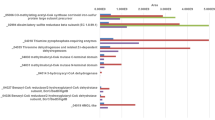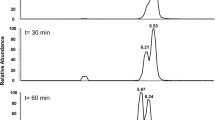Abstract
From anaerobic digestor sludge of a waste water treatment plant, a gram-negative, strictly anaerobic sulfate-reducing bacterium was isolated with acetone as sole organic substrate. The bacterium was characterized as a new species, Desulfococcus biacutus. The strain grew with acetone with doubling times of 72 h to 120 h; the growth yield was 12.0 (±2.1) g · [mol acetone]-1. Acetone was oxidized completely, and no isopropanol was formed. In labelling studies with 14CO2, cell lipids (including approx. 50% PHB) of acetone-grown cells became labelled 7 times as high as those of 3-hydroxy-buyrate-grown cells. Enzyme studies indicated that acetone was degraded via acetoacetyl-CoA, and that acetone was channeled into the intermediary metabolism after condensation with carbon dioxide to a C4-compound, possibly free acetoacetate. Acetoacetyl-CoA is cleaved by a thiolase reaction to acetyl-CoA which is completely oxidized through the carbon monoxide dehydrogenase pathway. Strain KMRActS was deposited with the Deutsche Sammlung von Mikroorganismen, Braunschweig, under the number DSM 5651.
Similar content being viewed by others
References
Bergmeyer HU (ed) (1983) Methods of enzymatic analysis, vol I–III. Verlag Chemie, Weinheim
Bonnet-Smits EM, Robertson LA, Van Dijken JP, Senior E, Kuenen JG (1988) Carbon dioxide fixation as the initial step in the metabolism of acetone by Thiophaaera pantotropha. J Gen Microbiol 134:2281–2289
Cline JD (1969) Spectrophotometric determination of hydrogen sulfide in natural waters. Limnol Oceanogr 14:454–458
Daniels L, Fuchs G, Thauer RK, Zeikus JG (1977) Carbon monoxide oxidation by methanogenic bacteria. J Bacteriol 132:118–126
Diekert GB, Thauer RK (1978) Carbon monoxide oxidation by Clostridium thermoaceticum and Clostridium thermoaceticum. J Bacteriol 136:597–606
Dimroth P, Hilpert W (1984) Carboxylation of pyruvate and acetyl coenzyme A by reversal of the Na+ pumps oxaloacetate decarboxylase and methylmalonyl-CoA decarboxylase. Biochemistry 23:5360–5371
Hall LM (1962) Preparation of crystalline lithium acetoacetate. Anal Biochem 3:75–80
Hilpert W, Schink B, Dimroth P (1984) Life by a new decarboxy-lation-dependent energy conservation mechanism with Na+ as coupling ion. EMBO J 3:1665–1670
Unternational Union of Biochemistry. Nomenclature committee (ed) (1984) Enzyme nomenclature. Academic Press, Orlando, USA
Johnson MJ (1949) A rapid micromethod for estimation of non volatile organic matter. J Biol Chem 181:707–711
Law JH, Slepeky RA (1961) Assay of poly-β-hydroxybutyric acid. J Bacteriol 82:33–36
Lukins HB, Foster JW (1963) Methylketone metabolism in hydrocarbon utilizing mycobacteria. J Bacteriol 85:1074–1087
Mandel M, Igambi L, Bergendahl J, Dodson MR jr, Scheltgen E (1970) Correlation of melting temperature and cesium chloride buoyant density of bacterial deoxyribonucleic acid. J Bacteriol 101:330–338
Pfennig N, Trüper HG (1981) Isolation of members of the families Chromatiaceae and Chlorobiaceae. In: Starr MP, Stolp H, Trüper HG, Balows A, Schlegel HG (ed) The prokaryotes, vol I. Springer, Berlin Heidelberg New York, pp 279–289
Pfennig N, Wagener S (1986) An improved method of preparing wet mounts for photomicrographs of microorganisms. J Microbiol Methods 4:303–306
Platen H (1989) Abbau von Aceton und höheren aliphatischen Ketonen durch anaerobe Bakterien. Thesis, Universität Tübingen, FRG
Platen H, Schink B (1987) Methanogenic degradation of acetone by an enrichment culture. Arch Microbiol 149:136–141
Platen H, Schink B (1989) Anaerobic degradation of acetone and higher ketones via carboxylation by newly isolated denitrifying bacteria. J Gen Microbiol 135:883–891
Platen H, Schink B (1990) Enzymes involved in anaerobic degradation of acetone by a denitrifying bacterium. Biodegradation (submitted)
Postgate JR (1959) A diagnostic reaction of Desulphovibrio desulphuricans. Nature 183:481–482
Schauder R, Eikmanns B, Thauer RK, Widdel F, Fuchs G (1986) Acetate oxidation to CO2 in anaerobic bacteria via a novel pathway not involving reactions of the citric acid cycle. Arch Microbiol 145:162–172
Schink B, Pfennig N (1982) Fermentation of trihydroxybenzenes by Pelobacter acidigallici gen. nov. sp. nov., a strictly anaerobic, non-sporeforming bacterium. Arch Microbiol 133:195–201
Siegel JM (1950) The metabolism of acetone by the photosynthetic bacterium Rhodopseudomonas gelatinosa. J Bacteriol 60:595–606
Spormann AM, Thauer RK (1988) Anaerobic acetate oxidation to CO2 by Desulfotomaculum acetoxidans. Arch Microbiol 150:374–380
Stams AJM, Kremer DR, Nicolay K, Weenk GH, Hansen TA (1984) Pathway of propionate formation in Desulfobulbus propionicus. Arch Microbiol 139:167–173
Stern JR (1956) Optical properties of acetoacetate-S-coenzyme A and its metal chelates. J Biol Chem 221:33–44
Stern JR, del Campillo A, Raw I (1956) Enzymes of fatty acid metabolism. I. General introduction; crystalline crotonase. J Biol Chem 218:971–983
Stieb M, Schink B (1989) Anaerobic degradation of isobutyrate by methanogenic enrichment cultures and by a Desulfococcus multivorans strain. Arch Microbiol 151:126–132
Süßmuth R, Eberspächer J, Haag R, Springer W (1987) Biochemisch-mikrobiologisches Praktikum. Thieme, Stuttgart, FRG
Thauer RK, Jungermann K, Decker K (1977) Energy conservation in chemotrophic anaerobic bacteria. Bacteriol Rev 41:100–180
Taylor DG, Trudgill PW, Gripps RE, Harris PR (1980) The microbial metabolism of acetone. J Gen Microbiol 118:159–170
Widdel F (1980) Anaerober Abbau von Fettsäure durch neu isolierte Arten Sulfate-reduzierender Bakterien. Thesis, University Göttingen, FRG
Widdel F (1988) Microbiology and ecology of sulfate- and sulfur-reducing bacteria. In: Zehnder AJB (ed) Biology of anaerobic microorganisms. Wiley, New York, pp 469–585
Widdel F, Pfennig N (1981) Studies on dissmilatory sulfate-reducing bacteria that decompose fatty acids. I. Isolation of a new sulfate-reducer enriched with acetate from saline environments. Description of Desulfobacter postgatei gen. nov. sp. nov. Arch Microbiol 129:395–400
Widdel F, Pfennig N (1984) Dissimilatory sulfate- or sulfur-reducing bacteria. In: Krieg NR, Holt JG (eds) Bergey's manual of systematic bacteriology, vol I. Williams & Wilkins, Baltimore, USA, pp 663–679
Widdel F, Kohring GW, Mayer F (1983) Studies on dissimilatory sulfate-reducing bacteria that decompose fatty acids. III. Characterization of the filamentous gliding Desulfonema limicola gen. nov. sp. nov., and Desulfonema magnum sp. nov. Arch Microbiol 134:286–294
Zamenhoff S (1957) Preparation and assay of desoxyribonucleic acid from animal tissue. In: Colowick SP, Kaplan NO (eds) Methods in enzymology, vol III. Academic Press, New York, pp 696–704
Author information
Authors and Affiliations
Rights and permissions
About this article
Cite this article
Platen, H., Temmes, A. & Schink, B. Anaerobic degradation of acetone by Desulfococcus biacutus spec. nov.. Arch. Microbiol. 154, 355–361 (1990). https://doi.org/10.1007/BF00276531
Received:
Accepted:
Published:
Issue Date:
DOI: https://doi.org/10.1007/BF00276531




